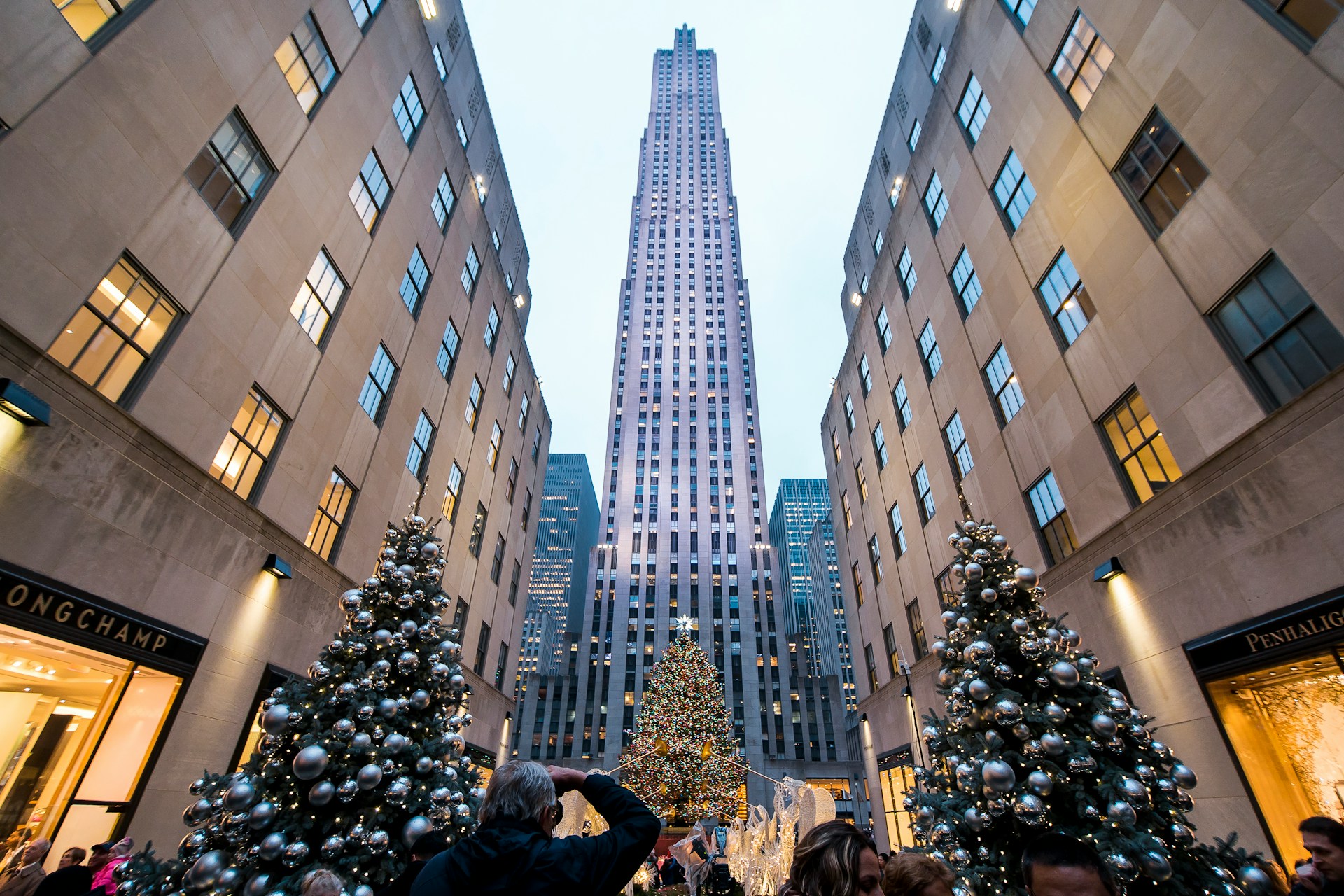Christmas in the United States: Something for Everyone!
Christmas in the United States is a vibrant blend of religious observances, secular traditions, family customs, and festive entertainment. For some Americans, Christmas is primarily a Christian and religious holiday. For others, the holiday is a purely secular celebration of food, family, gifts, and good cheer. This reflects the nation’s cultural diversity and deep love for the holiday season. From midnight church services to twinkling lights, the celebration is a time of joy, reflection, and connection for most Americans, regardless of religious beliefs or cultural background.
Religious Observances
For many Americans, Christmas remains rooted in its Christian origins. It is first and foremost a celebration of the birth of Jesus Christ. Churches across the country host special services on Christmas Eve and Christmas Day. These feature scripture readings, nativity plays, and hymns like Silent Night and O Holy Night. Midnight Mass is a particularly cherished tradition for Catholics, while Protestant churches often hold candlelight services. These moments of worship provide a serene contrast to the bustling preparations leading up to the holiday. But many Americans enjoy both the religious and the secular sides of the Christmas season. So it completely common for Christian Americans to spend the week shopping for gifts and enjoying images of Santa Claus before going to church on Sunday.
Since Hanukkah usually falls right around Christmas every year, you’ll also see Hanukkah decorations. It’s very common to see municipal or public decorations for both holidays side by side, since the US Constitution forbids favoring one religion over another. So most Americans are perfectly used to seeing a festive menorah alongside a Christmas tree. It all makes for a more festive atmosphere!
Another year-end holiday you may come across in the US is Kwanzaa. Kwanzaa is a week-long celebration honoring African American heritage, culture, and community, observed from December 26 to January 1. The central themes of the holiday are unity, self-determination, and collective work. The most common decoration is the seven candled kinara, which is lit as part of the celebration, along with storytelling, and shared meals.
Secular Traditions
While Christmas of course holds religious significance, it has also become a largely secular celebration. The United States is a country of immigrants, with many religious backgrounds, as well as no religious background at all. All Americans can find something to celebrate, and people of various faiths and backgrounds embraced Christmas. Secular symbols like Santa Claus, reindeer, and Christmas trees dominate the season. Town squares light up with towering evergreens and public Christmas tree-lighting ceremonies. These are often accompanied by parades and community gatherings.
Holiday movies, from classics like It’s a Wonderful Life to modern favorites like Elf, play on repeat in homes across the country. There are also many holiday specials and Christmas shows for children and family, including Frosty the Snowman, Rudolph the Red Nosed Reindeer, and others. Many families also participate in Secret Santa or White Elephant gift exchanges at work, school, or with friends. Whether you’re in a home, a store, a school, or an office, you can expect to see images of holiday cheer.
The Merry Christmas/Happy Holidays Debate
Americans love to disagree and argue when it comes to cultural or political identities. Christmas is not isolated from this argument. In fact, it’s quite central, as demonstrated by the debate on which holiday greeting is appropriate. For Christian American, the only acceptable greeting is Merry Christmas. You’ll see signs and bumper stickers that proclaim that “Jesus is the reason for the season” or “Keep the Christ in Christmas!” Some Christian Americans are so offended to hear a non-religious greeting during the holidays that they claim that there is a “war on Christmas,” and their beliefs and religion are being attacked.
Many other Americans think that this is nonsense. They prefer greetings like “Happy Holidays” or “Season’s Greetings,” because they do not want to assume that someone is Christian. Christianity is the majority religion in the US, but it is far from the only religion. Many Americans feel that it is important to show respect toward other Americans of all backgrounds – Jewish, Muslim, Hindu, Buddhist, Atheist, etc. – so they opt for a neutral greeting.
And a lot of Americans think that the entire debate is nonsense. Why get offended over a greeting? You may hear Americans covering all of their bases, for example when wishing a cashier at a store “Merry Christmas, Happy Holidays, Happy Hannukah, Joyous Kwanzaa, happy whatever you celebrate!” This captures the belief that most Americans hold: the US is a country of immigrants, with a wide variety of cultures and religions. As long as you’re nice, you’re welcome and respected.
Family Customs
Christmas is a time for families to come together and create cherished memories. Many households begin the season by decorating their homes with wreaths, lights, and ornaments. They hang stockings by the fireplace in anticipation of Santa’s arrival. (Santa will fill the stocking with small gifts, called “stocking stuffers,” to accompany the larger gifts under the tree!) Many Americans go to great lengths to decorate the exteriors of their houses for Christmas. If you drive through an American neighborhood, you’ll see elaborate decorations covering houses and front lawns: lines of colored lights, snowmen, Santa Claus and his sleigh, reindeer, angels, nativity scenes, and much more.
Santa Claus
Santa Claus is of course a major symbol of the Christmas holiday. According to tradition, he lives at the North Pole with his wife, Mrs. Claus, along with elves and reindeer. The elves build toys in their workshop all year round in preparation for Christmas Eve. Santa has a magical power of knowing which children are good and which children are naughty, and he keeps a list all year. Good children will get treated to his gifts, and naughty children may get a lump of coal instead! On Christmas Eve, Santa fills his magic sleigh with toys for all of the children of the world, and he and his flying reindeer visit homes all over the planet. The sleigh lands on the roof, and Santa slips down the chimney to leave gifts in stockings and under the Christmas tree. For children, the night of December 24th is filled with excitement as they leave cookies and milk for Santa and carrots for his reindeer. Every American child has tried to stay up late on Christmas Eve to hear Santa’s sleigh land on the roof.
On Christmas morning, children dash out of their bedrooms to find the assortment of gifts under the tree. Then, families gather around the tree to exchange gifts, a tradition symbolizing generosity and love. The day is often spent playing games, watching holiday movies, or engaging in outdoor activities like sledding, depending on the region. Naturally there’s also a lot of cleaning up of torn wrapping paper, too.
Food and Festivities
Christmas dinner in the U.S. is a feast that reflects the nation’s culinary diversity. Traditional dishes might include roast turkey or ham, mashed potatoes, stuffing, and green bean casserole. These are often accompanied by pies like pumpkin, pecan, or apple. In some households, unique cultural influences add tamales, latkes, or seafood to the menu, creating a deliciously varied celebration.
Baking is another hallmark of the season, with families making gingerbread houses, sugar cookies, and other festive treats together. Hot cocoa, eggnog, and mulled cider are popular beverages that add warmth to the holiday spirit.
Music and Shopping
The sounds of Christmas are everywhere, from carolers singing door-to-door to ubiquitous holiday playlists in malls and on the radio. Songs like “Jingle Bells” and “All I Want for Christmas Is You” evoke festive joy, while others like “Ave Maria” bring a sense of peace and reverence.
Shopping plays a central role in the American Christmas experience. Americans usually have quite a long list of people to buy gifts for. Right after Thanksgiving, Black Friday and Cyber Monday kick off a season of gift-buying, with malls and online retailers bustling until Christmas Eve. Elaborately wrapped presents under the tree are an enduring symbol of the holiday’s spirit of giving.
Christmas in the United States is a season of both sacred reflection and joyful celebration. Whether through religious observances, family traditions, or secular festivities, the holiday fosters a sense of togetherness and goodwill that transcends its many customs. It’s a time to cherish loved ones, spread kindness, and embrace the magic of the season.
Get on the road to better English with the Language Garage!
We hope you’ve enjoyed learning about the traditions associated with Christmas in the United States. If you’re interested in ESL/EFL lessons, please check out our English courses. We have private lessons, lessons for you and a friend or colleague, or small groups. Or see our other posts on English grammar, vocabulary, and more.
Photo by Elias Andres-Jose on Unsplash






